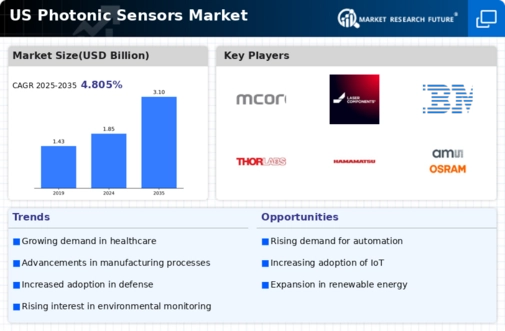Rising Demand for Smart Devices
The increasing demand for smart devices is a pivotal driver for the photonic sensors market. As consumers and industries alike seek enhanced functionality and connectivity, photonic sensors are becoming integral components in smart technologies. These sensors facilitate improved performance in devices such as smartphones, wearables, and smart home systems. The market for smart devices is expected to reach $1 trillion by 2026, with photonic sensors playing a crucial role in enabling features like gesture recognition and environmental monitoring. This trend indicates a robust growth trajectory for the photonic sensors market, as manufacturers strive to incorporate advanced sensing capabilities into their products to meet consumer expectations.
Government Initiatives and Funding
Government initiatives and funding aimed at promoting research and development in photonic technologies are significantly influencing the photonic sensors market. Various federal programs are designed to support innovation in sensor technologies, particularly in defense, healthcare, and environmental monitoring. For example, the National Science Foundation has allocated substantial resources to projects focusing on photonic sensor applications. This financial backing not only stimulates technological advancements but also encourages collaboration between academia and industry. As a result, the photonic sensors market is likely to benefit from increased investment, leading to enhanced product offerings and market expansion in the coming years.
Growing Focus on Energy Efficiency
The growing focus on energy efficiency is driving the photonic sensors market as industries seek to reduce operational costs and environmental impact. Photonic sensors offer precise measurements that contribute to energy management systems, enabling organizations to optimize energy consumption. For instance, in manufacturing, these sensors can monitor equipment performance and detect inefficiencies, leading to significant energy savings. The market for energy-efficient technologies is projected to grow substantially, with photonic sensors playing a vital role in achieving sustainability goals. This trend suggests that the photonic sensors market will continue to thrive as businesses increasingly prioritize energy efficiency in their operations.
Expansion of Telecommunications Infrastructure
The expansion of telecommunications infrastructure is a critical driver for the photonic sensors market. As the demand for high-speed internet and reliable communication networks increases, photonic sensors are essential for monitoring and managing network performance. These sensors enable real-time data transmission and enhance the reliability of communication systems. The telecommunications sector is expected to invest over $300 billion in infrastructure development by 2027, creating substantial opportunities for the photonic sensors market. This growth indicates a strong correlation between telecommunications advancements and the demand for photonic sensors, suggesting a promising outlook for the market in the near future.
Technological Advancements in Sensing Technologies
The photonic sensors market is experiencing a surge due to rapid technological advancements in sensing technologies. Innovations in materials and fabrication techniques have led to the development of highly sensitive and accurate photonic sensors. These advancements enable applications across various sectors, including telecommunications, automotive, and healthcare. For instance, the integration of photonic sensors in autonomous vehicles enhances safety and efficiency by providing real-time data on environmental conditions. The market is projected to grow at a CAGR of approximately 15% from 2025 to 2030, driven by these technological improvements. As industries increasingly adopt these advanced sensors, the photonic sensors market is likely to expand significantly, reflecting the growing demand for precision and reliability in sensing applications.























Leave a Comment